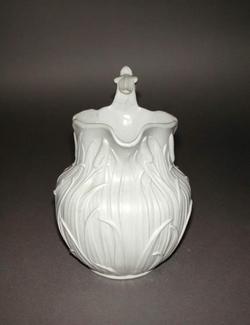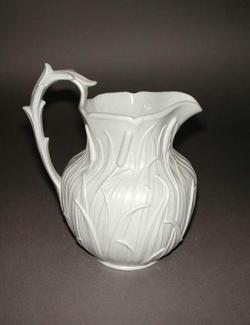Current Location: Gallery 27 (Glaisher)
Titles
'Bulrush' jug
Maker(s)
Production:
Ridgway & Abington
William Ridgway & Co
Entities
Categories
Description
Pale grey, relief moulded, smear glazed, stoneware.
Water jug, circular in plan with bulbous body, short, slightly flared, neck, pinched spout and over-arching handle, standing on a thin footring. The neck is shaped in a rough hexagon, with the rim shaped to match the sections. The exterior is decorated with naturalistic bulrushes, in relief, the leaves running from foot to shoulder or rim. The handle is also shaped as a bulrush and leaves. The outside is smear-glazed, the interior fully glazed and shiny. The underside is recessed and smear-glazed.
Notes
History note: Countess Shelagh S. Rietberg, Cambridge
Legal notes
Given by Countess Shelagh S. Rietberg, Cambridge, 1981
Measurements and weight
Height: 20 cm
Width: 18 cm
Acquisition and important dates
Method of acquisition: Given
(1981)
by
Rietberg, Shelagh, Countess
Dating
19th Century, Mid
Victorian
Circa
1848
CE
-
1850
CE
Note
Relief moulded jugs were popular in mid 19th Century homes. The smear-glazing makes the most of the way that colour-stained clays show off crisply-moulded ornament, whilst the stoneware would be durable in an everyday setting. There are several examples in the Fitzwilliam Collection. This jug’s bulrush design indicates its function, as a water jug.
The Ridgway family produced stoneware and porcelain in Staffordshire from the 1790s until the 20th Century. Trained by their father, Job, the brothers William and John already had a reputation for drab (coloured) stoneware decorated with applied relief sprigs when William Ridgway established Church Works, Hanley, in 1831. He was also a noted philanthropist, building alms houses and a school for local children – many of whom he employed in his potteries. With his partner James Leonard Abington and (later) his son Edward, by 1843 he operated six pot-works in Hanley and Shelton. The business became known for its relief-moulded jugs, for which it is likely that Abington was the modeller, and was re-named Ridgway & Abington in 1845. One of the first to offer such jugs, in the early 1830s, they produced some 26 designs over the next 30 years. Other potters followed, notably Minton and Charles Meigh, and relief moulded jugs (some with ceramic or metal lids) in a wide variety of design became a popular household mainstay for water, beer milk and other liquids which might now be kept in bottles, cans or plastic jars.
The decoration is unusual. However, an 1849 review in The Journal of Design and Manufactures commends it over the more common use of narrative or classical designs: 'The bulrush jug is calculated for a large sale, by reason, as it seems, of its demanding probably little labour to finish it, and its consequent cheapness… we presume [it] is for tee-totallers, from the watery character of its ornament’. The same design was used on a mustard pot and a sugar box, both with metal lids, and some jugs have ‘BULRUSH’ impressed on the base; only two Ridgway jug designs were named in this way. The design seems to have instigated a new fashion, as several other potteries, notably Dudson, produced naturalistic relief moulded jugs from the 1850s. It may have been influenced by Richard Redgrave’s 1847 ‘Well Spring’ carafe, is decorated with water weeds and flower heads, which is also in the Fitzwilliam Collection (C.50-1972).
People, subjects and objects depicted
Components of the work
Decoration
composed of
glaze
Materials used in production
pale grey
Stoneware
Techniques used in production
Press-moulding
: Press-moulded, smear-glazed stoneware with glazed interior.
Smear-glazing
References and bibliographic entries
Identification numbers
Accession number: C.47-1981
Primary reference Number: 75217
Stable URI
Audit data
Created: Saturday 6 August 2011
Updated: Tuesday 30 April 2024
Last processed: Tuesday 13 May 2025
Associated departments & institutions
Owner or interested party:
The Fitzwilliam Museum
Associated department:
Applied Arts






